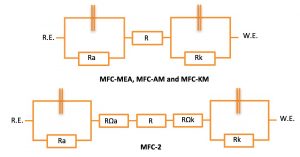Latest Research :
| Design of Reactor Side Feeding with Flow Reversal as a New Method for Manipulation of Local Elementary Reaction Yogi Wibisono Budhi |
| [bg_collapse view=”link-inline” color=”#4a4949″ icon=”arrow” expand_text=”Show Abstract” collapse_text=”The simulation of dynamic reverse flow operation (RFO) with reactor side feeding for selectivity issue during exothermic reaction, while incorporating mass and energy balances both solid phase and gas phase, is presented in this paper. This reactor operation was proposed with aim to avoid the conversion decrease during regular RFO. In addition, the manipulation of the product distribution became another opportunity for improved reactor performance. The reactor model consisted of mass balances on the level of elementary steps, which led to detailed dynamic influence of flow reversal effect on kinetics. The energy balance was incorporated with lean heat release due to very small concentration of reactant, diluted by inert. The model resulted in partial differential equation for mass balance in the gas phase, heat balances either in the gas phase and solid phase, and ordinary differential equation for mass balance in the solid phase. All differential equations were simultaneously solved using a software package FlexPDE version 7. The results showed the production rate of the desired product can be kept at high level, which may exceed the level of regular RFO and even of steady state operation (SSO). Even for the quasi-steady state regime, the reverse flow reactor with side feeding shows a different product distribution in comparison to SSO. The influence of shifting the feed positions to the reactor center is most pronounced. The reverse flow operation with reactor side feeding is a prime key for improved conversion and manipulation of product distribution.” ][/bg_collapse] |
| Influence of Solvent Degradation to the CO2 Absorption | Decolorization of Crude Terpineol by Adsorption Method | |
| Dr. Antonius Indarto and Dr. Anggit Raksajati | Dr. Antonius Indarto, Dr. Megawati Zunita Tatang Hernas Soerawidjaja, and Yansen Hartanto |
| Membrane Technology for CO2 removal: Membrane Gas Separation vs. Membrane Contactor | Utilization of Ultrafiltration Membranes in Parmesan Cheese Making from Cow Milk | |
| Mubiar Purwasasmita, I Gede Wenten, Ph.D., Dr. Anggit Raksajati, Khoiruddin,ST, MT | Lienda Aliwarga H, Henry Sutjiono, ST, Cindy, ST |
| Metal Removal from Lube Oil using Membrane Filtration | Study of Electrolyte Diffusion through Charged Swelling Membrane | |
| Dr. Danu Ariono, Dr. Subagjo and Prof. I Gede Wenten, Ph.D. | Dr. Danu Ariono, Prof. I Gede Wenten, Ph.D, Prof. Dr. Subagjo, and Anita Kusumawardani, S.T., M.T. |
| Study of Protein Separation on Charged Ultrafiltration Membrane | Combined ultrafiltration-electrodeionization technique for production of high purity water | |
| Dr. Danu Ariono, I Gede Wenten, Ph.D, Prof. Dr. Subagjo, and Anita Kusumawardani, S.T., M.T. | Prof. I Gede Wenten, Ph.D., Prof. Dr. Subagjo, Dr. Danu Ariono, Khoiruddin, S.T., M.T. |
| Zero Sludge Palm Oil Milling Plant using Superhhydrophobic Membrane based Oil-Oil Extraction | Sulfonation of Methyl Ester in Falling Film Reactor to Produce MES (Biosurfactant) | |
| Prof. I Gede Wenten, Ph.D., Prof. Mubiar Purwasasmita |
Dr. Retno Gumilang Dewi, Dr. Utjok W. R. Siagian |
| Development of Fischer-Tropsch Catalyst for Liquid Fuel Production | Development of Electrodeionization Module for High Salinity | |
| I.G.B.N. Makertihartha, Dr. Subagjo, Dr. Melia Laniwati, Zaki Al Fathoni, MT | Dr. Subagjo, Danu Ariono, Prof. I Gede Wenten, Ph.D., Khoiruddin, ST, MT |
| Metal Oxide based Antibacterial Membrane and Active Substances of Natural Material for Wastewater Treatment | Development of metal ion separation process from mine waste processing industry by membrane (Nanofiltatrion & Ultrafiltration) based on graphene oxide. | |
| Dr. Megawati Zunita, S.Si., M.Si., I Gede Wenten, Ph.D.,Yuda Satria Syafii, and Firmansyah Agil Saputra |
Dr. Megawati Zunita, S.Si., M.Si., I Gede Wenten, Ph.D., Putu Teguh Dharmawijaya, S.T., Ratri Irawanti, S.T.,and Zulhaj Rizki, S.T., M.Sc. |
| Utilization of Vetiver Grass Containing Metals as Lignocellulosic Raw Materials for Bioethanol Production | Selection of Negative Carbon Emission Technology in Power Plant’s Fuel Combustion Process | |
| Dr. Elvi Restiawaty, Arinta Dewi |
Dr. Retno Gumilang Dewi, Dr. Utjok Siagian, Dr. Anggit Raksajati, Zakiah D. Nurfajrin, Bayu Wisnu Aji |
| Molecular Zeolite Assessment for Adsorption of Gas Molecules | ||
| Dr. Antonius Indarto, Dr. Megawati Zunita and Dr. Pramujo Widiatmoko |


